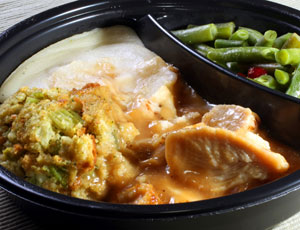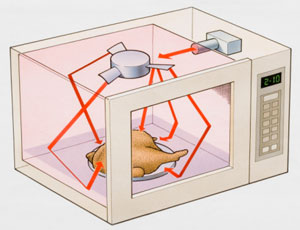
(Photo: iStockPhoto)
A fixture in homes, office break rooms, and convenience stores for decades, the microwave oven heats our frozen foods, leftovers, and even more elaborate meals in the blink of an eye. A microwave is typically more energy efficient than conventional ovens and ranges, making it a greener cooking choice at times.
Yet search the Internet for "are microwave ovens safe," and you'll get a barrage of hits from concerned parents and others who are worried that the handy device might have a dark, even dangerous side.
Of course, the prevailing consensus among scientists, public health experts, government agencies, and the general populace is that microwave ovens are overwhelmingly safe when used as directed. However, it's also true that there may be some legitimate questions about the safety of certain aspects of the technology.
Let's take a closer look at some myths, facts, and misconceptions about microwave ovens, which are estimated to be used in at least 90% of American homes.

Heating plastics in a microwave can be dangerous
Status: Fact
The safest course of action is to avoid putting any plastics in the microwave.
When the Milwaukee Journal Sentinel tested plastics labeled microwave-safe and advertised for infants, even those were found to release "toxic doses" of Bisphenol A when heated in a microwave. "The amounts detected were at levels that scientists have found cause neurological and developmental damage in laboratory animals," the paper reports.
In fact, the term "microwave safe" is not regulated by the government, so it has no verifiable meaning. According to the Journal Sentinel's testing, BPA "is present in frozen food trays, microwaveable soup containers, and plastic baby food packaging."
It is often found in plastics marked No. 7, but may also be present in some plastics labeled with Nos. 1, 2, and 5 as well, according to the report. Better to stick to glass or ceramics.
Metals get dangerously hot in microwaves
Status: Myth
Metals reflect microwaves, whereas plastic, glass, and ceramics allow them to pass through. That means metals don't appreciably heat up in a microwave oven.
However, thin pieces of metal, such as foils or the tines of a fork, can act as antenna, and the microwaves can arc off them, forming dramatic sparks.

Microwaves leak unsafe levels of electromagnetic radiation
Status: Myth (at least most of the time)
For decades, scientists and consumers have debated the possible effects of non-ionizing electromagnetic radiation on living tissue. It's very difficult to sort out the various risks we might get from fields emitted from power lines, cell phones, airplane flights, computers, clock radios, and, of course, microwave ovens. We know strong fields raise cancer rates and other problems, but what about the cumulative effect of small exposure or the effects on children?
No one knows, although we can take heart that the FDA limits the amount of microwaves that can leak from an oven throughout its lifetime to levels "far below the level known to harm people."
The federal standard also requires all ovens to have two independent interlock systems that stop the production of microwaves the moment the latch is released or the door opened. It's also true that microwave energy decreases dramatically as you move away from the source of radiation. So, if you are concerned, you can simply step away from the microwave when in use.
In an interview with TDG, mechanical engineer Mark Connelly, the deputy technical director of Consumer Reports, said that the vast majority of microwave ovens his group has tested have shown "very little leakage of radiation."
Asked if people should avoid looking into a working microwave, since the eyes are known to be the most sensitive to that form of radiation and are known to develop cataracts at high field strengths, Connelly said he didn't think it mattered, "since the window is shielded, and there shouldn't be leakage through that."
"If you are concerned, then go out and spend $20 on a testing kit to reassure yourself that there isn't any radiation leaking from your microwave," Connelly added. He said his testing of consumer-grade kits has shown them to be reasonably reliable, despite some press accounts to the contrary. "Microwaves can wear over time, with gaskets wearing or trouble developing in the door. So I think it's prudent to spend a little money to test them," he said.
Boiling a cup of water in a microwave can cause it to explode
Status: Fact
One potential danger of microwave ovens is getting scalded by over-heated water. When plain water is heated in a microwave in a clean ceramic or glass container for too long, it can prevent bubbles from forming, which normally cool the water down. So the water becomes superheated, past its boiling point. When it is disturbed, say by moving it or dropping something in it, the heat is released violently, erupting boiling water out of the cup.
To avoid this risk, heat water only the minimum amount of time needed. Or place a wooden spoon or stick in it.

Microwave ovens cook food from the inside outside
Status: Myth
Although many people believe this to be the case, microwaves actually work on the outer layers of food, heating it by exciting the water molecules there. The inner parts of food are warmed as heat transfers from the outer layers inward.
This is why a microwave can only cook a big hunk of meat to a depth of about one inch inward.
You can't heat oils in a microwave
Status: Fact
Oils such as olive oil do not heat well in microwaves because their molecules lack the polarity found in water. It's also true that frozen butter is hard to thaw in a microwave, because the bulk of the substance is oil, and the portion of water present is in the form of ice, which keeps the molecules locked up in crystal form, making oscillation more difficult.
Microwaves alter food in undesirable, possibly unsafe, ways
Status: Undetermined but unlikely
It's a fact of life that any type of cooking changes the chemistry of food. Cooking can reduce the levels of some nutrients, just as it can increase the levels of others or make them more or less available to the body for use. (Raw food anyone?)
The prevailing view is that microwaves do not alter foods in ways that are any more deleterious or harmful than other types of cooking. In fact, some have argued that the faster cooking time may actually preserve more nutrients versus other methods.
Still, we know sufficiently little about nutrition and the cumulative effects of food science so some people aren't convinced. E Magazine pointed out that popular holistic health expert Dr. Andrew Weil has written, "There may be dangers associated with microwaving food ... there is a question as to whether microwaving alters protein chemistry in ways that might be harmful."
The conclusion made by government agencies and mainstream organizations is that microwaved food is safe, as well as convenient. There are a limited number of studies that may suggest otherwise, but given the lack of large-scale or compelling evidence it's hard to feel that tossing out your microwave is a particularly smart step.
Everyone interviewed for this piece pointed to other issues as more pressing, from ubiquitous exposure to cell phones to more serious threats from radon or bigger energy users like heating and cooling. That doesn't mean microwaves aren't worth thinking about, however.
Wikio
No comments:
Post a Comment